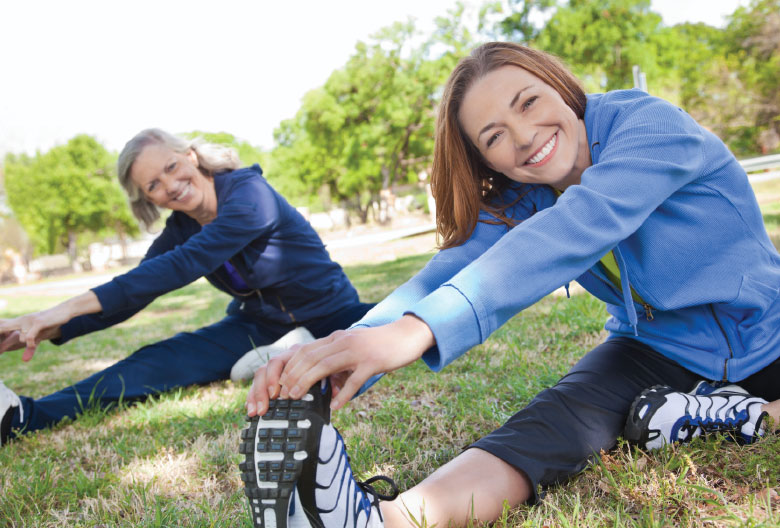- The American Heart Association recommends at least 150-minutes of moderate activity each week
- About 80% of Americans fail to meet minimal activity goals.
- Although there is a focus on moderate or vigorous activity (see definitions below), light activity can also make real improvements in health.
Too much sitting and other sedentary activities can increase your risk of cardiovascular disease. Adults who watch more than 4 hours of television a day had a 46% increased risk of death from any cause and an 80% increased risk of death from cardiovascular disease.
The Physical Activity Guidelines for Americans, therefore, recommend at least 150 minutes of moderate-intensity activity (that is 30 minutes at least 5 days a week, but three 10-minute periods of activity are as beneficial to your overall fitness as one 30-minute session) or 75 minutes of vigorous-intensity activity per week.
A little exercise goes a long way
Recent studies would recommend adding just two minutes of walking each hour in combination with their normal activities can go a long way.
- Just trading 2 minutes/hour of sedentary activity with light-intensity activity was linked to 33% lower mortality in the general population and 41% lower risk of death in those with chronic kidney disease (CKD), according to a recent study (Clinical Journal of the American Society of Nephrology, April 30, 2015 )
Indeed, it doesn’t take much exercise to derive a benefit: the most recent evidence suggests that much less physical exercise than previously believed can have important health benefits: such as running (or its equivalent) for as little as 5-15 minutes at slow speeds (less than 6 mile/h) can be healthy and even life-saving and may motivate sedentary individuals to “move more.”
- A study of more than 50,000 adults with average age of 44 years studied at the Cooper Clinic, Dallas compared runners with non-runners. The runners had 30% lower risk of death and a 45% lower risk of death due to cardiovascular cause during a 15-year follow-up. This translates to a 3-year life expectancy benefit of surprisingly little daily exercise. This study may motivate healthy but sedentary individuals to begin and continue running for substantial and attainable mortality benefits. (Lee, D. Leisure-Time Running Reduces All-Cause and Cardiovascular Mortality Risk J Am Coll Cardiol 2014;64(5):472-481).
Simply adding more walking into daily life whether in increments of 10 to 15 minutes or 30 minutes all at once can improve your metabolism and even add more quality and years to your life. A pedometer is a great way to start and track progress with a goal of getting 10,000 steps in daily. Research shows that walking 10,000 steps a day will significantly improve your health, endurance, burn calories, lower BP and give you a healthier heart. Being physically active and walking and light jogging are almost uniformly beneficial for health and do increase life span. It’s a simple idea: walk more. Even moderate walking has proven results and is a recommendation virtually for all Americans and is an important contributor to the “healthy” life-style.
Quick tips on how to move more:
- Park your car further away at stores
- Get off the bus or subway a few stops earlier
- Dance more
- Use a stationary bike while watching TV
- Make family time active—ride bikes, play outside, go to a park, walk the neighborhood
- Walk the stairs instead of the elevator
Measuring Physical Exertion:
METS and exercise: exercise physiologists define 1 metabolic equivalent (or 1 MET) as 3.5 mL O2 uptake/kg per min, which is the resting oxygen uptake in a sitting position. In other words, 1 MET = the energy (oxygen) used by the body at rest, while sitting quietly or reading a book, for example. The harder your body works during the activity, the more oxygen is consumed and the higher the MET level. Examples of physical activities and MET levels:
- Activity that burns 3 to 6 METs is considered moderate-intensity physical activity.
- Activity that burns > 6 METs is considered vigorous-intensity physical activity.
The 10 Met goal
Most middle-aged Americans who can achieve 10 METS of aerobic activity are considered to be at an optimal physical activity level (women in general have a lower maximal aerobic capacity than men and 10 METS in men is equivalent to 8 METS). The 10 Metabolic Equivalents (10 METS) level is a reasonable goal for optimized health and is the equivalent of 20 minutes of moderate paced walking or about 2000 steps).
- A recent 2013 study that included mostly men who presented for stress-testing found that those achieving 10 METS or more (had an excellent prognosis and a statistically important lower risk of cardiovascular events compared to those who could not reach this level. (Fine NM et al Mayo Clin Proc. 2013;88(12):1408-1419
Moderate Activity is 3-6 METs (3.5 to 7 kcal/min)
Examples of moderate activity include:
- Walking at a brisk pace of 3 to 4.5 mph on a level surface
- Cycling at 5-9 mph on a level surface
Vigorous Activity is 6 METs (more than 7 kcal/min)
Examples of vigorous activity include:
- Running at 5 mph or greater
- Cycling at 10 mph or greater or cycling on steep terrain
Summary
Regular exercise will make you feel better, help you achieve an ideal weight, lower your risk of heart disease and stroke to a greater degree than most medications. It will improve your self-image and reduce the negative effects of aging on brain and bodily function. Although a moderate to vigorous exercise pattern is advised for best results benefits are seen when going from sedentary to even low levels of activity. What are you waiting for?

